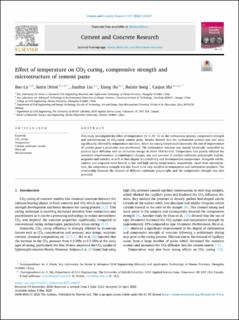| dc.contributor.author | Lu, Bao | |
| dc.contributor.author | Drissi, Sarra | |
| dc.contributor.author | Liu, Jianhui | |
| dc.contributor.author | Hu, Xiang | |
| dc.contributor.author | Song, Baixin | |
| dc.contributor.author | Shi, Caijun | |
| dc.date.accessioned | 2023-01-04T13:07:10Z | |
| dc.date.available | 2023-01-04T13:07:10Z | |
| dc.date.created | 2022-05-05T09:47:17Z | |
| dc.date.issued | 2022-05-05 | |
| dc.identifier.issn | 0008-8846 | |
| dc.identifier.uri | https://hdl.handle.net/11250/3040964 | |
| dc.description.abstract | This study investigated the effect of temperature (5 ◦C–50 ◦C) on the carbonation process, compressive strength and microstructure of CO2-cured cement paste. Results showed that the carbonation process and rate were significantly affected by temperature and time. When the curing temperature increased, the rate of improvement of cement paste’s properties was accelerated. The carbonation reaction was mainly kinetically controlled by product layer diffusion with an activation energy of about 10.8 kJ/mol. Temperature had greatly affected the structural transformation, morphological changes, size and amounts of calcium carbonate polymorphs (calcite, aragonite and vaterite) as well as their degree of crystallinity and decomposition temperature. Alongside calcite, vaterite and aragonite were formed at low and high curing temperatures, respectively. Apart from microstructure, the compressive strength was also found to be very sensitive to temperature and carbonation products. The relationship between the amount of different carbonate polymorphs and the compressive strength was also provided. | en_US |
| dc.language.iso | eng | en_US |
| dc.publisher | Elsevier | en_US |
| dc.relation.ispartofseries | Cement and Concrete Research;Volume 157, July 2022, 106827 | |
| dc.rights | Navngivelse 4.0 Internasjonal | * |
| dc.rights.uri | http://creativecommons.org/licenses/by/4.0/deed.no | * |
| dc.subject | CO2 curing | en_US |
| dc.subject | Temperatures | en_US |
| dc.subject | Calcium carbonate crystals | en_US |
| dc.subject | Silica gel | en_US |
| dc.subject | Microstructure | en_US |
| dc.subject | Microstructures | en_US |
| dc.title | Effect of temperature on CO2 curing, compressive strength and microstructure of cement paste | en_US |
| dc.type | Peer reviewed | en_US |
| dc.type | Journal article | en_US |
| dc.description.version | publishedVersion | en_US |
| dc.rights.holder | © 2022 The Authors | en_US |
| dc.source.articlenumber | 106827 | en_US |
| cristin.ispublished | true | |
| cristin.fulltext | original | |
| cristin.qualitycode | 2 | |
| dc.identifier.doi | https://doi.org/10.1016/j.cemconres.2022.106827 | |
| dc.identifier.cristin | 2021655 | |
| dc.source.journal | Cement and Concrete Research | en_US |
| dc.source.volume | 157 | en_US |
| dc.source.issue | 157 | en_US |
| dc.source.pagenumber | 1-12 | en_US |
| dc.relation.project | National Natural Science Foundation of China: U1605242 | en_US |
| dc.relation.project | National Natural Science Foundation of China: 52050410333 | en_US |
| dc.relation.project | National Natural Science Foundation of China: 52078204 | en_US |
| dc.relation.project | Key Laboratory for Advanced Technology in Envi ronment Protection of Jiangsu Province: JH201802 | en_US |
| dc.relation.project | Key Laboratory for Advanced Technology in Envi ronment Protection of Jiangsu Province: JH201845 | en_US |
| dc.relation.project | Science and Technology Program of Jiangsu Province: BZ2020012 | en_US |

